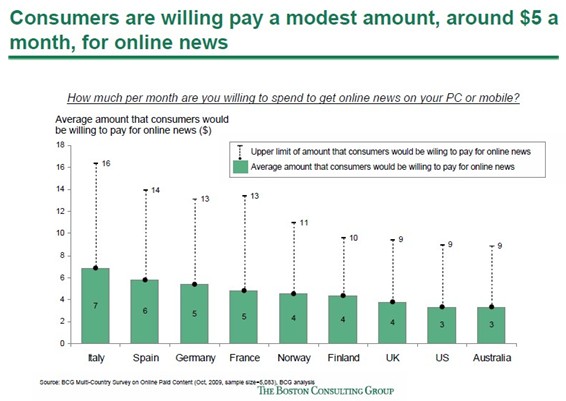Consumers are willing to spend small monthly sums to receive news on their personal computer and mobile devices, according to a study conducted by the Boston Consulting Group (BCG). US consumers say they are willing to pay an average $3 per month for meaningful online content; UK consumers say they would pay $4 per month.

US consumers are more likely to pay for certain types of content:
- Unique: 72% say they would pay for local and community-specific news; 73% say they would pay for specialized coverage, breaking news, or investigative reporting.
- Timely: 61% say they would pay for continuous news alert services.
- Convenient: 53% say they would pay for personalized online news from different sources.
US consumers are more likely to pay for online news provided by newspapers than by other media, such as television stations, websites, or online portals: 54% of them say they would pay for news provided by national newspaper websites, and 58% say they would pay for news from regional/local newspaper websites.
The survey also highlights the gap between those who say they are willing to pay for news and those who actually do pay for news. Some 48% of US consumers say they are willing to pay for online news, compared with 15% who report paying for online news.
Consumers' willingness to pay for online news does not fundamentally shift newspaper industry economics, BCG argues. An increase in revenue from consumers in the US would shift the current 80/20 percent mix of advertising to consumer pay only 2-3 percentage points, toward consumer pay, according to BCG’s calculations. Such a shift would impact profit margin, however, and possibly offset 1-3 years' worth of advertising declines that are forecast, it finds.
About the findings: The survey was conducted by the Boston Consulting Group via the Web in October. A total of 5,083 respondents participated in nine countries: the United States (1,006 respondents), Germany (1,006), Australia (529), France (510), the United Kingdom (506), Spain (505), Italy (504), Norway (259), and Finland (258). The respondents were equally divided between men and women and among four age ranges.



